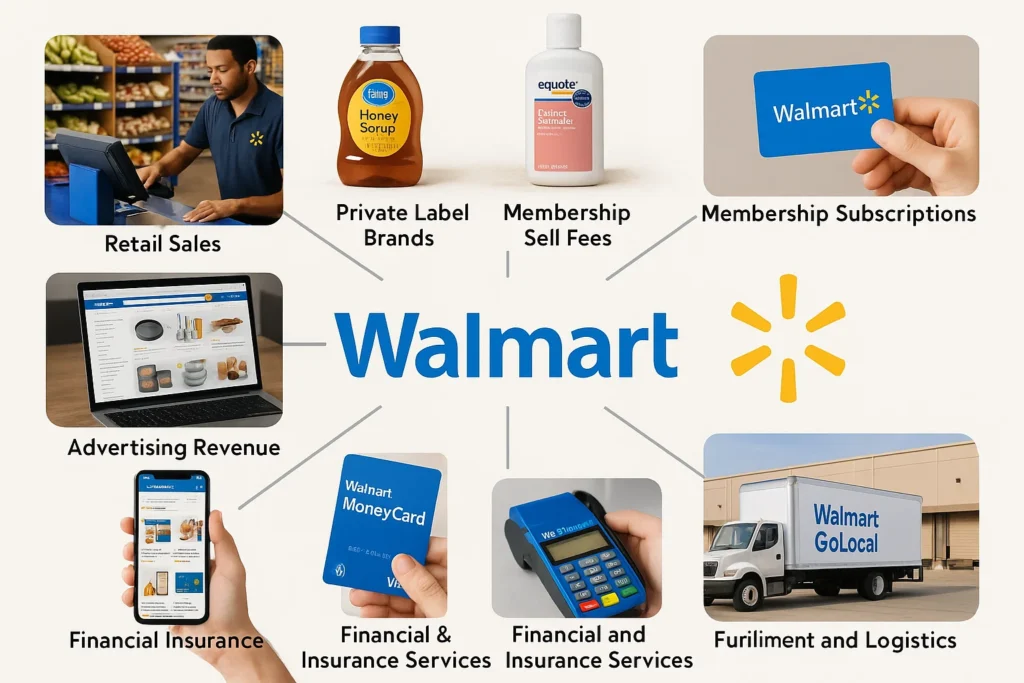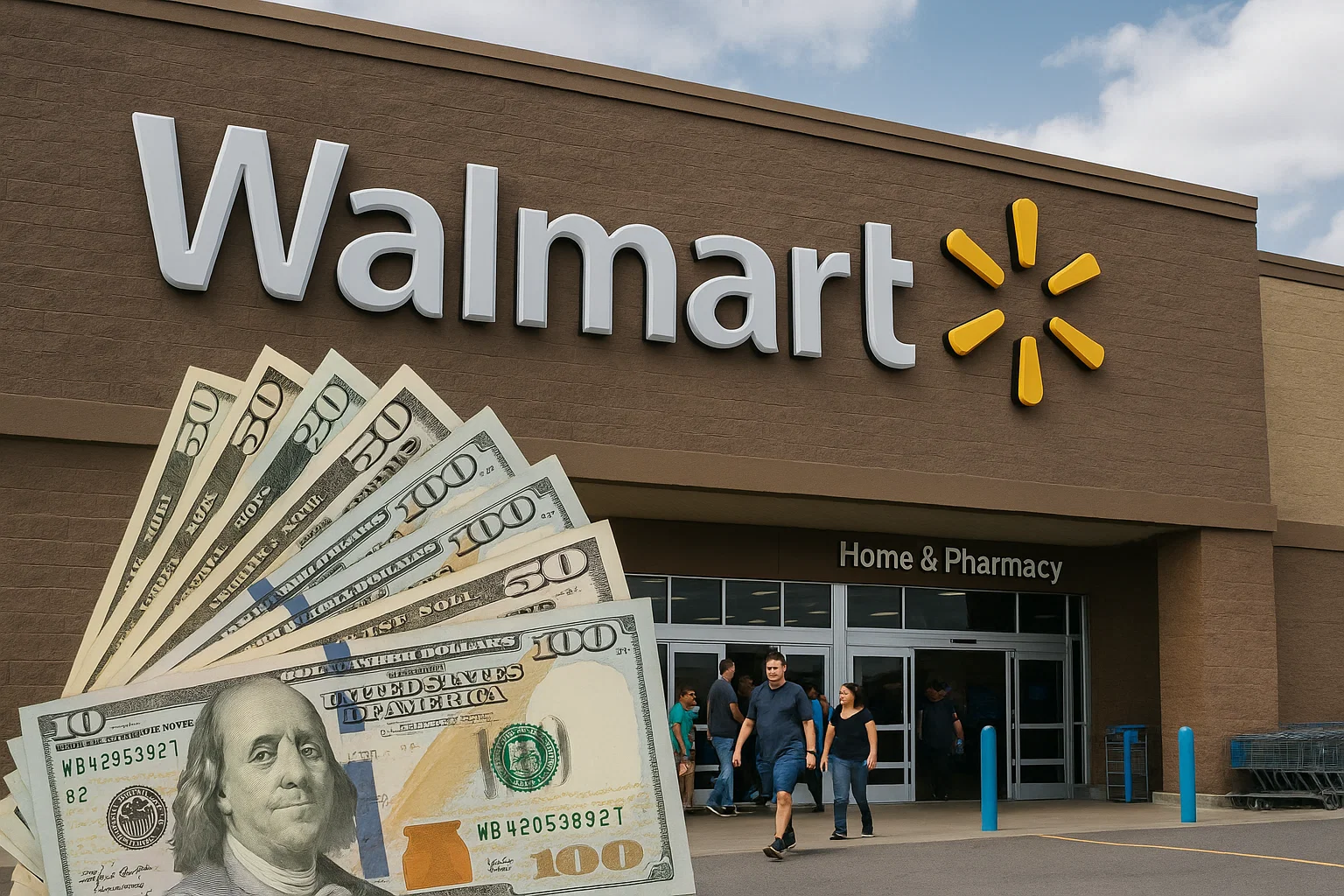Walmart, the world’s largest retailer, is more than just a hypermarket chain. It’s a global eCommerce, logistics, and technology powerhouse generating over $600 billion in annual revenue. What started as a small discount store in Arkansas has evolved into a retail behemoth operating across 20+ countries, with millions of customers shopping both online and in-store every day.
But how exactly does Walmart make money — especially in 2025, when eCommerce giants, fast-delivery startups, and direct-to-consumer brands are eating up market share?
This blog breaks down Walmart’s multi-pronged revenue model, from everyday low pricing in stores to AI-powered logistics, advertising networks, and paid membership programs. We’ll also explore how startups can replicate Walmart’s monetization model using a ready-to-launch Walmart Clone from Miracuves.
Launch your digital store with a leading e-commerce app development company trusted worldwide. Get the right features, scalability, and support to grow your online business.
How Walmart Makes Money
Walmart’s revenue model is built on high volume, low margin — but it doesn’t stop there. Over the years, it has evolved into a robust multi-channel machine with diverse income sources. Here are the key ways Walmart makes money in 2025:
- Retail Sales (In-store and Online) – Core earnings from selling groceries, apparel, electronics, and general merchandise.
- Private Label Brands – Higher-margin house brands like Great Value and Equate contribute significantly to profit.
- Membership Subscriptions (Walmart+) – A paid loyalty program offering free delivery, fuel discounts, and more.
- Marketplace Seller Fees – Commissions from third-party sellers on Walmart’s online marketplace.
- Advertising Revenue (Walmart Connect) – Brands pay for sponsored placements and targeted ads across Walmart’s digital properties.
- Financial and Insurance Services – Revenue from services like Walmart MoneyCard, credit partnerships, and bill pay.
- Fulfillment and Logistics Services – B2B logistics solutions for sellers and other retailers via Walmart GoLocal.

Walmart’s model is increasingly digital, diversified, and built for scale — combining the power of physical stores, data, and eCommerce into one monetization ecosystem.
Discover how Walmart stays ahead with powerful Walmart app features explained. Learn what makes it a benchmark for e-commerce apps worldwide.
Detailed Breakdown of Revenue Channels
Retail Sales (In-store and Online)
Walmart’s primary revenue still comes from the sale of consumer goods — groceries, electronics, clothing, home essentials, and more. While in-store sales dominate, eCommerce continues to grow fast, driven by mobile app orders, pickup, and delivery.
- Who Pays? Everyday customers and B2B buyers.
- Why It Scales? High footfall and digital adoption allow massive daily transaction volumes.
Private Label Brands
Walmart’s owned brands like Great Value, Sam’s Choice, and Equate provide higher margins than national brands. By controlling sourcing and packaging, Walmart improves profitability while offering low prices.
- Who Pays? Consumers choosing affordable alternatives.
- Why It Scales? Builds loyalty and margin with no dependency on external brands.
Walmart+ Membership
For $98/year, Walmart+ offers free delivery, fuel discounts, and in-store scan-and-go. This subscription adds recurring revenue and encourages frequent purchases — much like Amazon Prime.
- Who Pays? Loyal customers and frequent online shoppers.
- Why It Scales? Recurring income and higher customer lifetime value (CLTV).
Marketplace Seller Fees
Walmart allows third-party sellers on its marketplace, earning commission on each sale. It also offers premium services like fulfillment and advertising — all of which generate platform revenue without holding inventory.
- Who Pays? Independent sellers and DTC brands.
- Why It Scales? Asset-light growth via platform economics.
Walmart Connect Advertising
Brands pay for ad placements, banner spots, and promoted listings across Walmart’s digital assets. With millions of daily users and rich purchase data, Walmart offers serious ad targeting capabilities.
- Who Pays? Consumer brands and vendors.
- Why It Scales? Fast-growing digital ad market and high intent shoppers.
Financial and Insurance Services
Walmart offers prepaid debit cards (MoneyCard), installment financing, bill payments, and even health insurance signups — earning referral commissions and fees.
- Who Pays? Customers using financial services or insurance.
- Why It Scales? Drives inclusivity and financial access in underserved markets.
Fulfillment and Logistics (Walmart GoLocal)
Walmart now offers last-mile delivery and logistics services for other businesses. This white-label logistics service competes with Amazon Logistics and FedEx in certain segments.
- Who Pays? Small businesses, sellers, and retailers.
- Why It Scales? Monetizes excess delivery capacity with zero storefront risk.
Uncover the secrets behind Walmart’s success with our guide on the Walmart app strategy winning mobile commerce. Apply these insights to grow your own e-commerce app.
Why This Revenue Model Works in 2025
Walmart’s revenue strategy continues to thrive in 2025 because it is built on adaptability, scale, and data-driven operations. Here’s why it remains one of the most effective monetization models in modern retail:
Blended Physical + Digital Experience
Walmart’s omni-channel model — with physical stores, curbside pickup, mobile apps, and eCommerce — gives it a competitive edge over online-only retailers. Customers love the flexibility, and Walmart monetizes each touchpoint.
Subscription Economy Boom
With consumers increasingly opting into memberships for added value and savings, Walmart+ benefits from the growing subscription culture. Its low-cost, high-value structure drives customer retention and repeat purchases.
Retail Media Advertising Growth
Retail media is one of the fastest-growing ad segments in 2025. Brands are shifting budgets from traditional channels to performance-driven retail platforms. Walmart Connect capitalizes on this trend with targeted, high-ROI placements.
Cost-Conscious Consumers
In an inflation-conscious world, Walmart’s “Everyday Low Prices” resonate strongly. Its private labels and bulk deals align with the value-driven shopping habits of 2025, making it a go-to for millions.
Platformization of Retail
By enabling third-party sellers, Walmart turns itself into a platform — similar to Amazon. This allows scale without inventory risk, with additional income from logistics, fulfillment, and advertising.
AI and Automation Enhancements
Walmart uses AI for inventory forecasting, shelf scanning robots, and personalized product recommendations. This enhances operational efficiency and customer experience — critical for maximizing margins.
Explore Walmart’s business model in 2025 to see how the retail giant makes billions and what startups can learn. Plus, discover how the Walmart app works to understand the tech powering its success.
Can Startups Replicate Walmart’s Revenue Model?
Yes — but with smart shortcuts and the right tech stack.
Walmart’s revenue engine is powerful, but building it from scratch requires massive capital, supply chain depth, and advanced technology. For startups and digital agencies aiming to tap into retail and eCommerce, replicating Walmart’s monetization approach can be daunting — unless you start with a ready-made solution.
That’s where Miracuves makes a difference.
Our Walmart Clone is a turnkey platform that enables you to launch a full-featured retail and marketplace app in a fraction of the time and cost. It’s built to mirror the core monetization pillars of Walmart:
- In-app product sales (single-vendor or multi-vendor)
- Commission-based third-party seller marketplace
- Integrated logistics and delivery modules
- Subscription options for customers (like Walmart+)
- Ad placements for sellers and brands
- Support for private label promotions and dynamic pricing
- Payment, refund, wallet, and loyalty systems
With Miracuves, you get more than just an app — you get a revenue-ready business model backed by scalable tech, customizable UI, and enterprise-grade admin controls. Whether you’re launching in a single region or aiming for global reach, our clone helps you monetize from day one.
The Walmart Clone by Miracuves is priced at $2,899, designed for scalable and feature-rich multi-category eCommerce.
Manage products, inventory, and customer engagement effortlessly.
Go live in just 3–6 days with complete source codes.
Compare the best Walmart clone scripts in 2025 with features and pricing to kickstart your project. Learn how to build an app like Walmart with our full-stack guide and get a clear view of the Walmart app development cost in 2025 before you invest.
Conclusion
Walmart’s revenue model in 2025 is a blueprint for modern retail success. With a powerful mix of product sales, platform commissions, ad revenues, subscriptions, and value-added services, it monetizes every layer of the shopping experience — both offline and online.
For startups looking to break into eCommerce or retail tech, the opportunity is real — but the path doesn’t have to be slow or expensive. With Miracuves’ Walmart Clone, you can tap into the same monetization mechanics that fuel the world’s largest retailer. Whether you want to run a private-label store, build a seller marketplace, or offer subscription-driven shopping — the tech and business logic are already built-in.
FAQs
How does Walmart generate revenue?
Walmart generates revenue through retail product sales, private-label brands, marketplace seller commissions, subscriptions (Walmart+), advertising (Walmart Connect), financial services, and B2B logistics.
Is Walmart profitable in 2025?
Yes, Walmart remains highly profitable in 2025 thanks to its cost leadership, digital transformation, and growing income from high-margin services like advertising and subscriptions.
What are the main income sources for Walmart?
The main income sources include physical and online product sales, seller fees, membership subscriptions, in-app advertising, and value-added services like delivery and financial products.
Can startups use the same revenue model as Walmart?
Startups can replicate Walmart’s revenue model by combining eCommerce, logistics, subscriptions, and platform features — especially using white-label solutions like the Walmart Clone by Miracuves.
Does Miracuves offer a Walmart clone with monetization features?
Yes, Miracuves offers a fully customizable Walmart Clone equipped with commission systems, ad modules, delivery logistics, multi-vendor support, and subscription-based customer loyalty tools.








